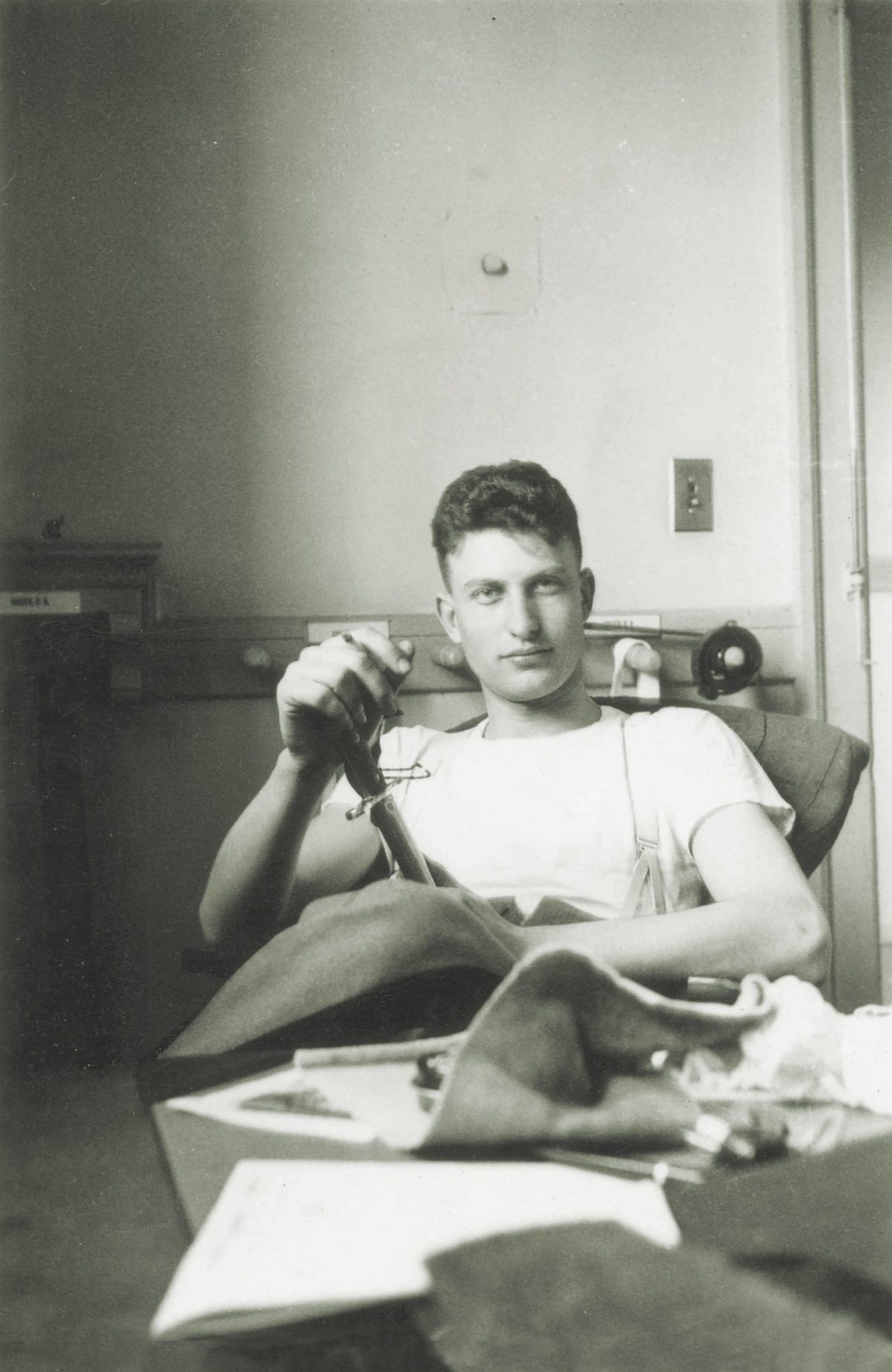Green grows the jungle, bright is the dew
HECTOR JOHN POLLA, C.1942
Sorry I am that I can’t get to you
Until our next meeting, here’s what we’ll do
We’ll change that red Sun,
to the Red, White and Blue!
I FIRST READ these words in one of a dozen remarkable notebooks that came to me in a large envelope some years ago. I had been aware of their author, a lieutenant in the 57th Infantry Regiment named Hector John Polla, as I’d written about him in my book, Black ’41: The West Point Class of 1941 and the American Triumph in World War II, which told the story of the class that had graduated literally into World War II. Among those 424 men, I had been especially captivated by the stories of Polla and two others who had been the first to face the enemy in ground combat. Polla, along with Californian Ira B. Cheaney and Floridian Alexander R. Nininger, were soldiers who had fought and been decorated in desperate battles on the front lines of the Philippines’ Bataan Peninsula long before most of their classmates had gone overseas.
With those notebooks in hand, Hector Polla now seemed much more real to me. They contained the words—prose, poetry, and meticulous checklists—he had penciled in the months after he was captured by the Japanese on Bataan in April 1942. Polla’s nephew, John Giorza, and his wife Jane had read my book and wanted to share with me the journals Polla had kept while in the infamous Japanese prison camp at Cabanatuan in the Philippines. I copied them and returned the originals to the family.
Some of the notebooks were tiny, vest-pocket ones, the kind that are easy to conceal—which almost certainly was what he did while imprisoned. Others were regular-sized school notebooks with the logo of the Philippine Commonwealth Bureau of Education on the front that the Japanese had probably pilfered and then sold to prisoners at the camp commissary. Polla used them to record the rules of card games in great detail and to jot notes in the Japanese language classes he took, probably voluntarily. He also recorded most of his poetry in the larger notebooks.
A few months ago, I ran across my copies of the notebooks. I looked again at the 1941 Howitzer—West Point’s yearbook—and at the photo of an earnest young man well-liked for having “lightened many tasks with his cheerful manner.” I reread the citation for his action on February 9, 1942, that earned him a Silver Star. It told of the lives he saved and the position that would not have been held without his bravery. Looking back, this citation is all the more poignant, for we know that the strategic situation for those troops in that place was hopeless, and that their short-term future held defeat, the hellish Bataan Death March, and imprisonment.
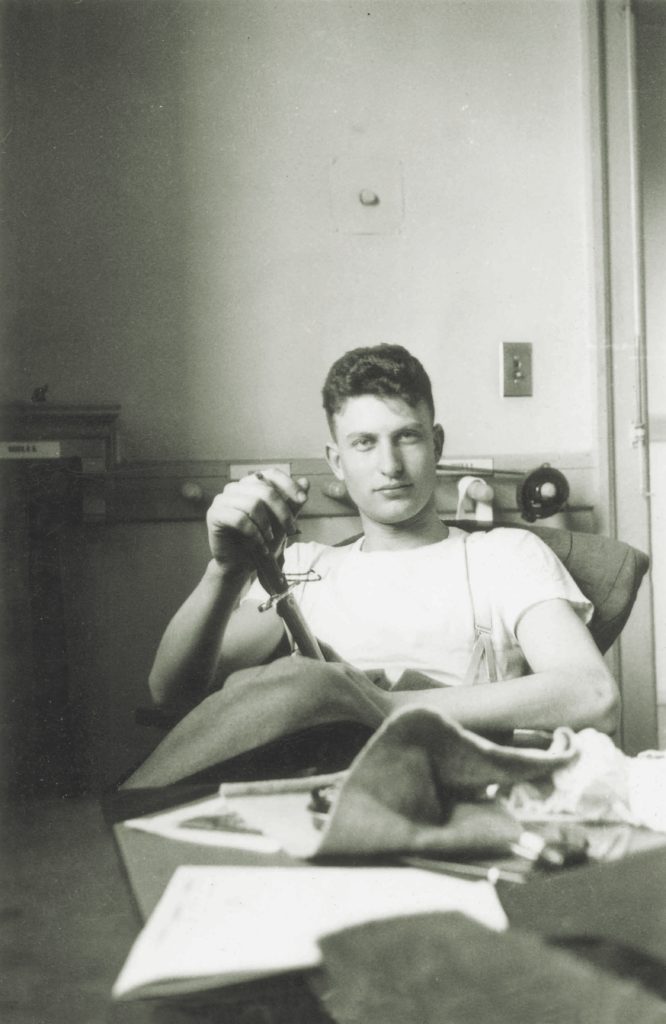
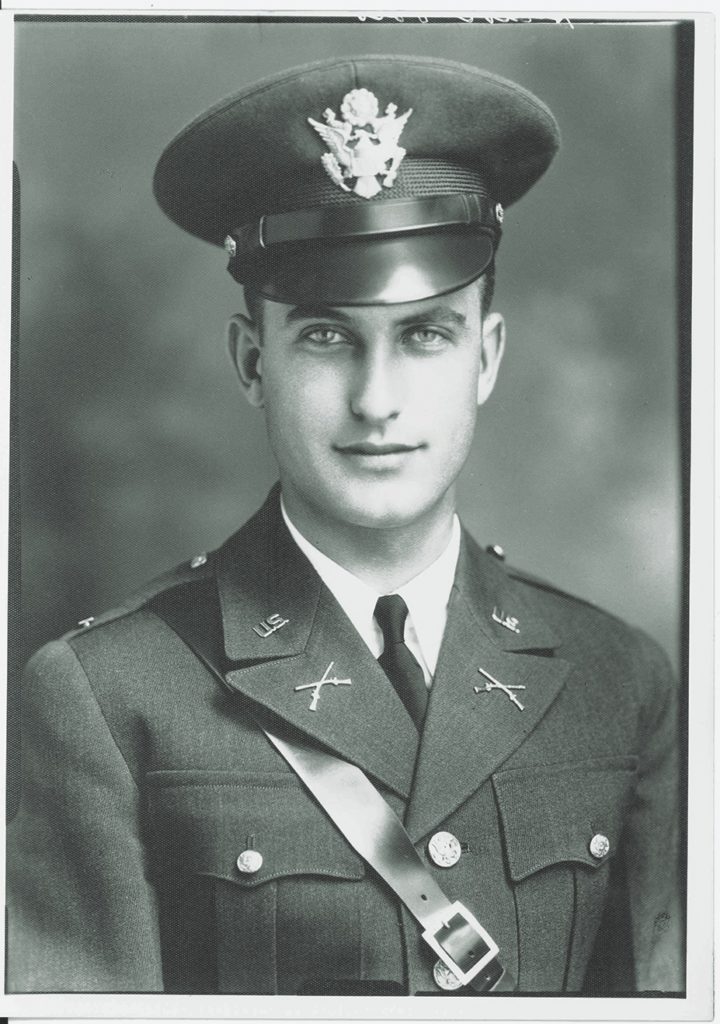
All-American Boy
HECTOR POLLA grew up in Pulaski County, Missouri. His parents, Lodovico “Vico” and Maddelina, were Italian immigrants; Vico worked as a gardener. Hector was an average kid: He had a paper route and liked to go fishing. In high school, he went out for basketball and football, and played clarinet in the band. After high school, Hector spent two years at the Wentworth Military Academy in Lexington, Missouri, before earning an appointment to West Point. Marcellus Hartman, a high school classmate of Hector’s, later told John Giorza: “I think it went through Vico’s mind that here I am a gardener…and my son is graduating from the U.S. Military Academy.”
After Infantry School at Fort Benning, Georgia, Polla, along with Cheaney and Nininger, arrived in the Philippines and joined the 57th Infantry Regiment on November 20, 1941. With its tropical setting and low-cost off-base living, the Philippines had been a prize assignment during the prewar years. Shortly after arriving, Polla dropped off a few dress uniform items at the Sanitary Steam Laundry in Manila to be cleaned and pressed, and settled in to savor the life of a young officer in the exotic Orient.
But he and his two classmates had little time for this. On December 8, as the attack on Pearl Harbor was underway across the International Dateline, the Japanese struck the Philippines. Two days later, the invasion began. Filipino and American defenders were knocked reeling, and within a few weeks the trio was among the outnumbered troops cornered in doomed Bataan. Cheaney and Nininger both lost their lives in January 1942. Cheaney was awarded a posthumous Distinguished Service Cross, and Nininger’s posthumous Medal of Honor was the first to be awarded to a U.S. Army soldier in a ground action during World War II. For Polla—promoted to first lieutenant on January 16—the Battle of Bataan continued.
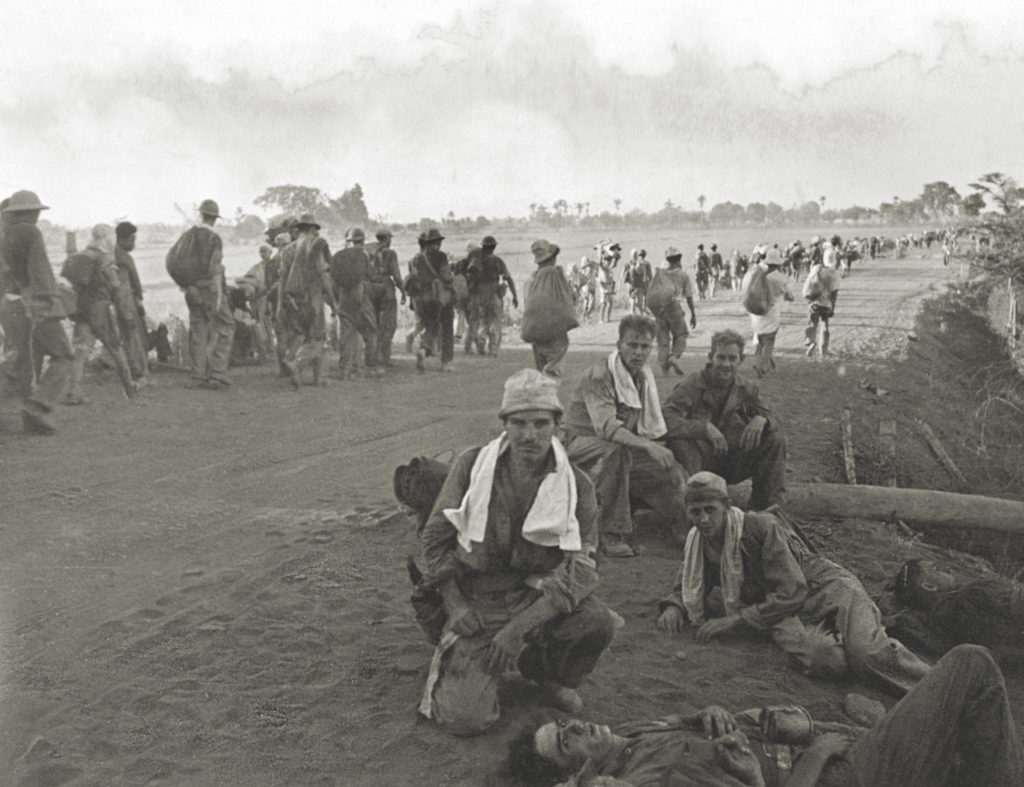
On April 9, two months to the day after he had risked his life to hold the American line, time finally ran out, and the last line could no longer be held. The American and Filipino defenders of Bataan surrendered, and Polla became one of some 60,000 men to face the 60-mile Bataan Death March, enduring unspeakable atrocities along the way. Men were beaten or shot for stopping to get a drink of water or aiding failing comrades.
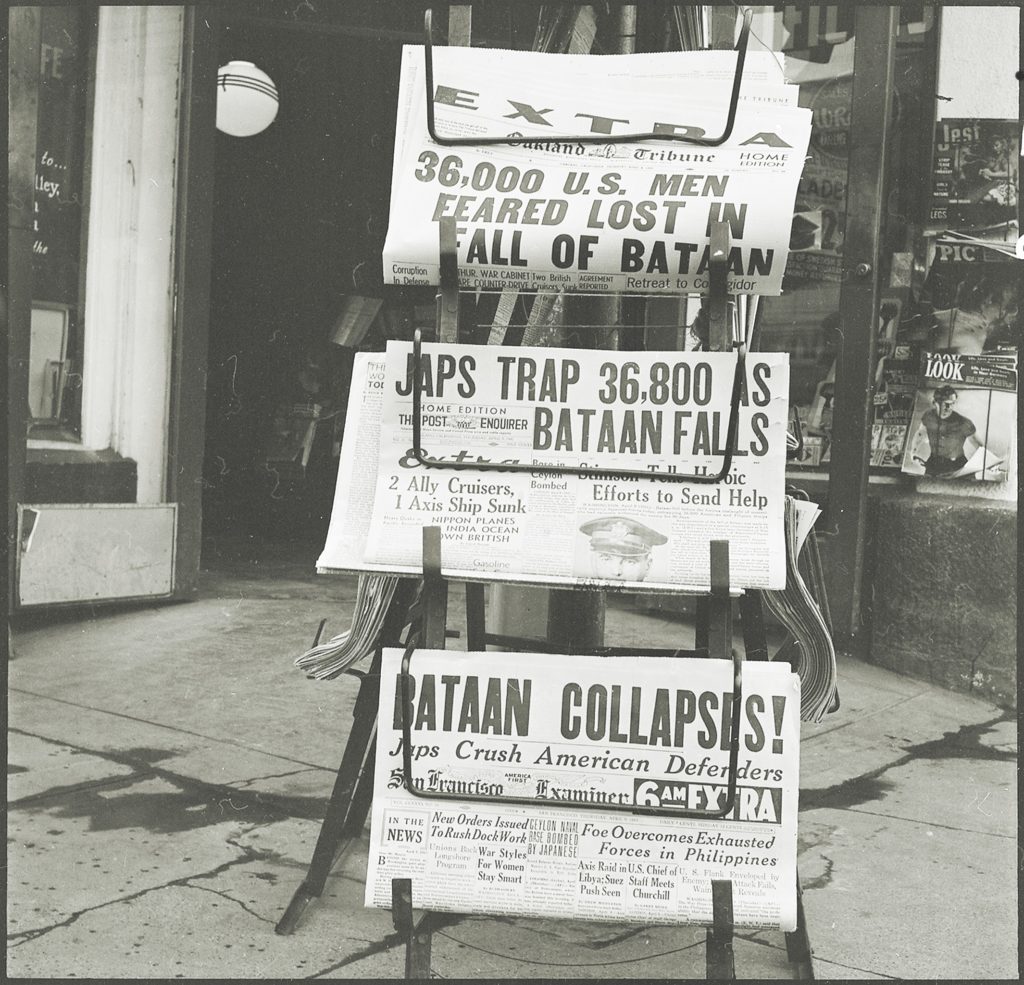
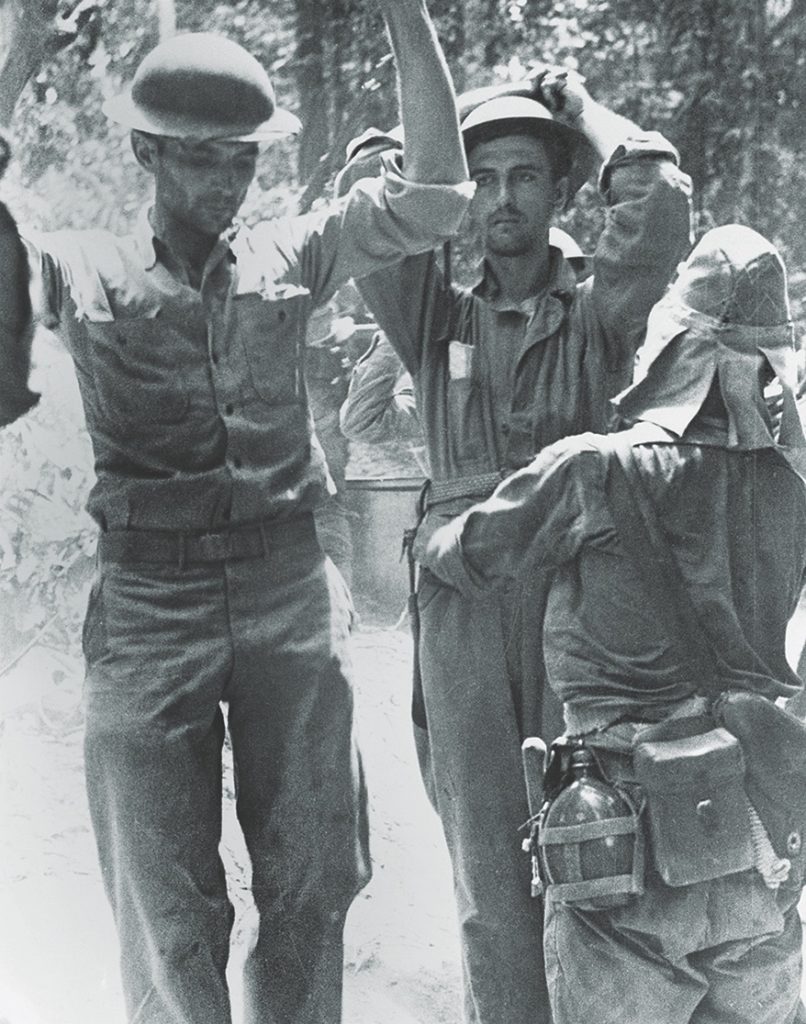
Finally reaching Cabanatuan on June 2, 1942, Polla and the others faced an uncertain future, with no idea of how long they’d be confined. Polla’s earliest notations in the small notebooks—generally undated—include lists of names and addresses of fellow inmates, the food they received from their captors, quotes from radio news reports listened to surreptitiously, and random thoughts: “Be sure roll calls are accurate”; “Camp Comdr. objects to assembles (illegal)”; “Excess rice in garbage pits to be reduced. Noticed by Nips.” His more systematic, day-by-day diary entries would not begin until the first day of 1943—by which time he knew he was in for a long haul.
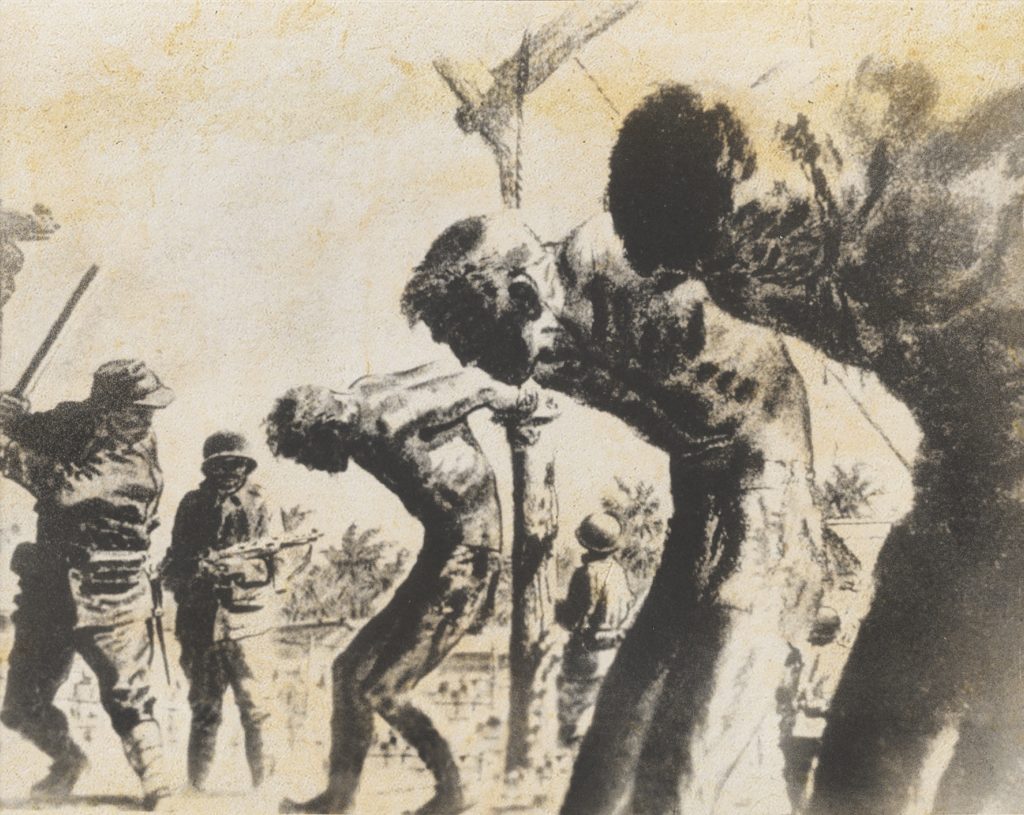
POLLA’S EARLY ENTRIES paint a mundane picture of camp life, at odds with virtually all postwar accounts of survivors who told of conditions at Cabanatuan as being miserable beyond measure, with brutal treatment by its guards. On January 5, for example, Polla wrote: “Bridge. One banana issued. One pack American cigarettes. Traded Old Golds for Camels.” February 18 was marked by bridge and a “Jap inspection of clothing…worse than at school.” But it all turned out okay: he was issued “two new shirts and a pair of pants.” He ended his day by listening to the radio.
On March 17, the Japanese passed out fish oil for shoeshining and a ration of tooth powder “for every three men.” Polla goes on to say that there was “a drawing for drawers and towel. I got the towel.” The next day, between the bridge game and an afternoon nap, Polla notes being “issued three limes.” That evening, there was a “Musical Show” of the sort that alternated with movie nights several times a week through 1943 and, with less frequency, into 1944.
Looking at what he wrote—and where he wrote it—raises questions that will never be answered. Were Polla’s bland descriptions of bridge, entertainment, and citrus fruit toned down for fear of what punishment might ensue if his diaries were discovered? If so, one wonders why he penned his poetry, some of which contained descriptions of cruelty and abuse, in the larger, harder-to-hide notebooks. Were his bland descriptions simply factual details recited by a benumbed man who had accepted his circumstances? Was the man who “lightened many tasks with his cheerful manner” just trying to maintain his own sanity? John Giorza suggests that Hector undertook his writing projects and diary-keeping as a means of maintaining his mental acuity.
Polla’s diary entries rarely ebbed on the darker side. On April 6, 1943, though, he mentioned that he had learned from a guard that two men had escaped, but noted nothing of their fate. One rare graphic description of his captors’ strong arm came just a few days later, on April 14, when he wrote tersely about a man who had been caught attempting an escape. He “was supposed to be shot — Head shaved — spared,” Polla wrote. To this, he added: “Rat crawled on my head.” Is Polla perhaps telling us that he was the man whose head was shaved?
However, he pulled no punches as he wrote in verse about 10 men executed for the transgressions of one. “The ten they knew that they must die, altho’ for truth they knew not why,” Polla wrote. “Their life had run its brief short span. They were paying the debt of another man.”
‘I want to go home’
POLLA’S POETRY is often wistful in tone— such as when he wrote, “They write of the East as enthralling, and that’s why I started to roam. But now I hear the Occident calling. Oh Lord, how I want to go home.”
The theme of abandonment also crops up. In his poem “Scuttlebutt,” probably dating from the summer of 1942, Polla borrowed a line from popular culture when he wrote that a “friend of a friend of a pal of mine” told of a confidential report that “the Yanks and the tanks are coming. In fact they are almost here.” Indeed, since January 1942, President Franklin D. Roosevelt and the U.S. Army chain of command had repeatedly promised the POWs that help was on the way. Those making the promises knew it was impossible, but those in Cabanatuan at first thought that their incarceration might be short. Polla ended “Scuttlebutt” by writing that the gossip of “old maids…couldn’t keep up with the rumors in Cabanatuan.”
Polla wrote often of food, a fixation common to people on greatly reduced diets. Steamed rice was the staple, and the prisoners were also often served lugao, the rice porridge common to the Philippines. In their early days of confinement, they ate creamed corn and canned salmon, probably from captured American food supplies.
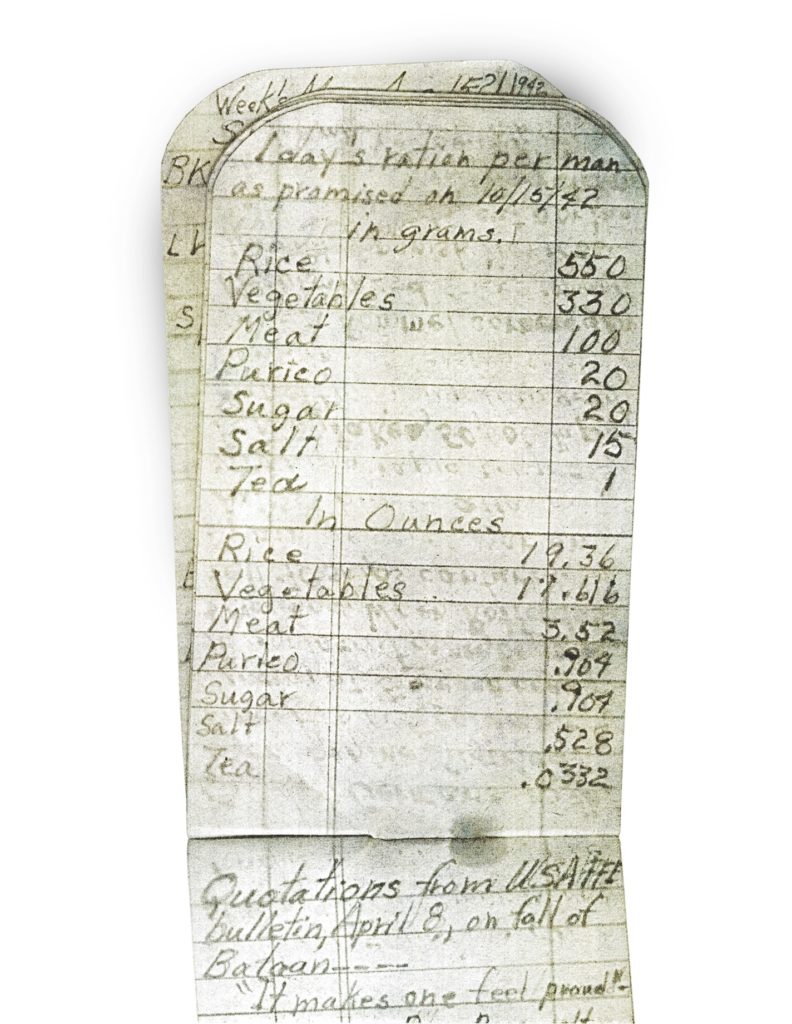

As the men of Cabanatuan neared their first Christmas in captivity, captured canned goods ran out, but the Japanese allowed gifts to reach the prisoners. Polla recalled that a delegation of “Manila Women” came to the camp with such treats as cigars, cigarettes, and candy. He does not say who these women were—although had they been from the Red Cross, he would have mentioned this, because he notes on the same page that International Red Cross packages with candy bars, soap, and canned goods also reached Cabanatuan ahead of Christmas 1942.
Through the early months of 1943, Polla wrote of eggs being served frequently for breakfast, and of oranges, limes, and Red Cross sugar often being distributed. On May 10, he savored “the first mango of the season.” Into 1944, Spam, jam, and canned corned beef arrived in Red Cross parcels. The men also maintained a farm outside the main prison compound. In his diary, Polla recalled raking cornstalks and being in charge of the camote (sweet potato) planting detail in the spring of 1943.
Polla’s weight, as an indication of his level of nourishment, declined from 163 pounds in October 1942 to 156 in February 1943 and stabilized in the low 150s through July 1944, the last time he noted it.
There was a hospital of sorts at Cabanatuan, overseen by a U.S. Army doctor, Colonel James Gillespie. Army Medical Department historian George Cressman has written that it “lacked the supplies and drugs to effectively treat patients.” However, Polla wrote at length about an early 1943 malaria affliction and that he received quinine routinely. He also often mentions other medications, including an antibiotic, sulfanilamide. In April 1944, he received a cholera vaccination and a month later he was back on quinine for another bout of malaria.
Aspirin was available, and circulated among the prisoners. “Valentine’s Day but no Valentine,” Polla wrote on February 14, 1943. “Stayed in the sack most of the day. Got 2 aspirins from Knopping.” This was his first mention of Warrant Officer Joseph Knopping, an aviation engineer from Palisades Park, New Jersey, who would play an important part in Polla’s story two years later.
Holidays in hell
THE JAPANESE regularly paid the prisoners small sums in Philippine pesos, which had a prewar value of about two cents in American dollars. The funds were kept in Japanese Postal Savings accounts. According to Polla’s running total—which reached 470 pesos by October 1944—he started out receiving five pesos monthly, but in October 1943, company grade officers like himself got a raise to 40 pesos. With their money, the prisoners were able to shop at the camp commissary, buying fresh fruit, canned coffee, toiletries, tobacco, and even fresh eggs. Polla was a regular consumer of sugared peanuts, which sold for 15 to 18 centavos a bag. Eggs fluctuated at a little less than one peso a dozen, about the same as the cost of a notebook.
Polla documented holiday celebrations. On Thanksgiving 1943, he reported having “had a very good supper.” Both Christmas Eve and New Year’s Eve in 1943 passed congenially with “cake and coffee.” On April 29, 1943, the men were served hotcakes for breakfast in celebration of Emperor Hirohito’s birthday. The same day one year later, however, was what he called a “Usual day.”
Polla did not mention his own birthday in 1943, but on September 30, 1944, as he turned 28, he reported eating cornbread and peanut butter. Easter 1943 was celebrated with a cup of sugar in the ration allotment, while on Easter 1944, he “attended sunrise services” and “broke out my new uniform.”
By his account, the Cabanatuan inmates stayed entertained. Performances by the camp theater companies and glee club occurred regularly in 1943, and he reviewed them. He deemed the glee club show on February 21 “very good,” while the variety program on March 6 was merely “pretty good,” and the film Tobacco Road on March 30 was “not too good.”
Movies, from the Marx Brothers to Snow White and the Seven Dwarfs—probably 16mm prints captured from American bases—were shown several times a week, often interspersed with Japanese newsreels. On September 12, 1943, Polla wrote “Movie — Judy Canova in Puddin’ Head enjoyed by all even though it was a second rate movie.” Ten days later, the 1931 Charlie Chaplin film City Lights earned a “very silly” from Polla. On October 21, he wrote: “Movie all in Japanese except a cartoon, ‘Looney Tunes.’ Cartoon only thing worthwhile.”
Reading Polla’s many movie reviews, like reading page upon page of a “bridge and citrus” lifestyle, is perplexing: it’s hard to square his journals’ account with the unanimously hellish stories of treatment at Cabanatuan that have emerged since the war. Was he trying to focus on the few glimmers of a bright side? Perhaps an answer to this question can be found in his penmanship and his language. By the summer of 1943, Polla’s handwriting had become more careless, as though he was running out of steam. His entries grew shorter, now usually being just one line. Indeed, for most of August, and sporadically into October, the phrase “Usual day” was repeated, with no further comment, day after day.
Letters from home reached the prisoners at Cabanatuan only sporadically at first, with a Christmas letter from Polla’s mother finally arriving in February 1943. Nearly a year later, in his January 1944 entries, he mentioned mail several times, noting that he received two letters in a day—one from his parents and another from a friend named Kay, from whom he received several letters. By June, it was a “Usual day” when 250 letters arrived at camp.
In reply, inmates were permitted to mail postcards with a 50-word message limit. Among those to his mother that survived the war, his card of July 22, 1944, said: “Don’t worry about me…send sunglasses when you can.” Perhaps his sanguine descriptions of Cabanatuan were in part designed to shield his mother from the anguish she would feel if she were ever to see his notebooks.
MEANWHILE, EVEN AS THE MAIL for the men started flooding in, the prisoners themselves began flowing out. The Japanese started pulling men out of Cabanatuan to be sent to Japan in “work details.” The most able-bodied of the men were, in fact, being conscripted as slave laborers, and were transported on vessels aboard which the conditions were so cruel and unsanitary that they came to be known as “hell ships.” Polla first mentioned a detail leaving for Japan on March 6, 1944. By the summer, the departing work details became more frequent, with the men often rousted around midnight to leave in the wee hours of the morning. Because they never returned, those left behind had no idea what they’d undergone.
Indeed, there was reason for optimism. By September 1944, as the prisoners marked 27 months of imprisonment, the fortunes of the once-invincible Imperial Japanese Army had ebbed and turned. Japan had been defeated from the Solomons to the Marianas, and General Douglas MacArthur’s promise of a return to the Philippines loomed large as an imminent reality. For Hector Polla, this was best recalled in his September 21 entry. After writing “Usual day” dozens of times, he was able to write “Unusual day.”
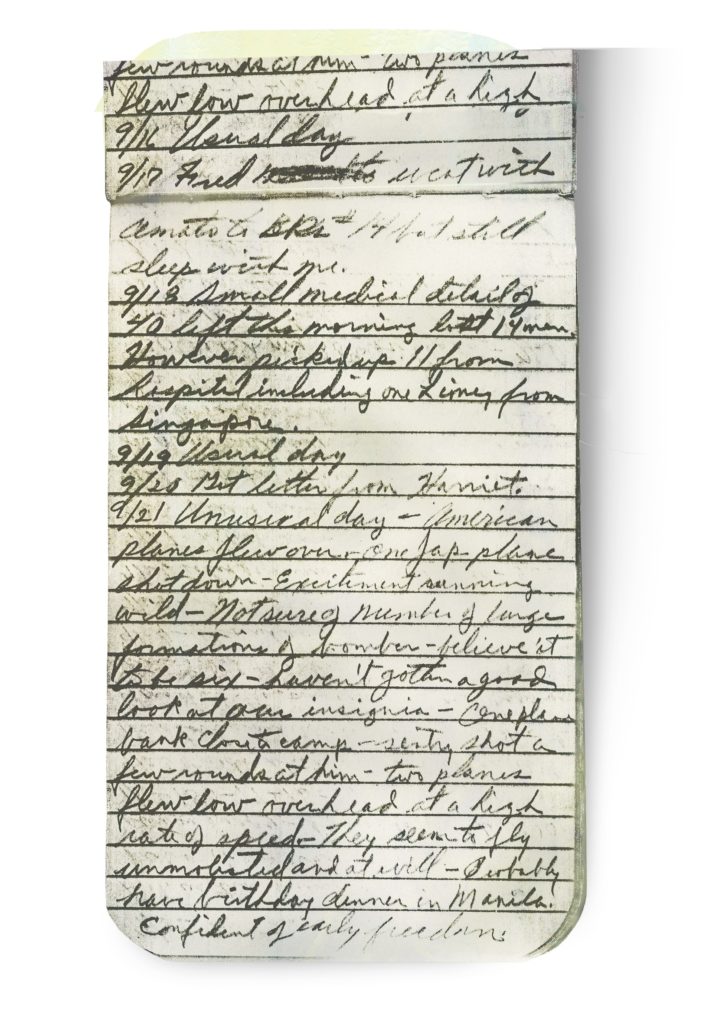
“American planes flew over,” he explained. “One Jap plane shot down — Excitement running wild…two planes flew low overhead at a high rate of speed. They seem to fly unmolested and at will… [I’m] Confident of early freedom.” He optimistically added “Probably have birthday dinner in Manila,” but that was not to be. On September 30, as he celebrated his 28th birthday, freedom was not his to grasp.
On October 15, it was Hector Polla’s turn to join a departing detail. His diary entry for that day, in the form of a note to his mother, was his last.
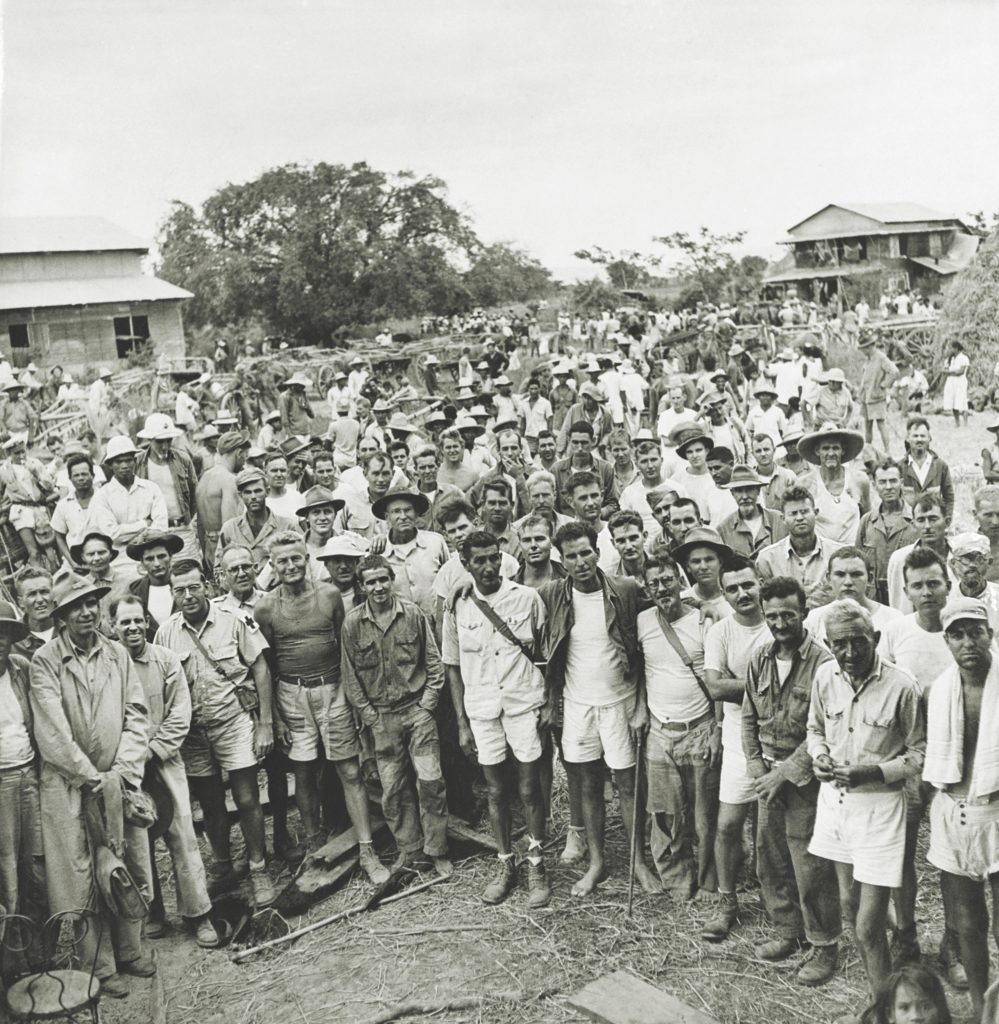
“Leave tonight at midnight. Giving [my notebooks] to Knopping to send on to you,” he told her, referencing Joseph Knopping, the man whose name had first appeared in his diary 20 months earlier. “I am in good health…. I don’t believe that we will leave the islands, but if we do you may rest assured that I will get along all right. I have been able to so far and I will continue to do so.”
Five days later, General MacArthur waded ashore on the island of Leyte at the head of his Sixth Army and the liberation of the Philippines began.
Based on eyewitness accounts later compiled by the U.S. Army, a reasonably accurate picture of Polla’s subsequent experiences can be pieced together. After two months at Manila’s Bilibid Prison, Polla was crammed into the filthy hold of the Oryoku Maru in Manila Harbor, along with 1,555 other Americans and 64 prisoners of war of other nationalities. On December 13, 1944, the ship departed for Japan. Two days later, though, like many Japanese ships in Philippine waters, the Oryoku Maru, unmarked as a POW transport, became a target of American aircraft. As it sank, 270 prisoners died. Polla was among the survivors who were reloaded aboard the Enoura Maru on December 27.
The ship reached Takao, Formosa (now Kaohsiung, Taiwan), on New Year’s Day 1945, and was still docked in port on January 9 when American bombers attacked it, heavily damaging—although not disabling—the ship and killing more than 400 POWs. But Hector Polla once again beat the odds.
On January 21, his luck ran out. His own undated poem, “Requiem,” provides a somber epitaph:
“God rest ye dead and rest ye well; T’is best ye be free’d from hell.”

Messages from the grave
IN JULY 1945, Vico and Maddelina Polla received a letter from Major General Edward F. Witsell, the U.S. Army’s soon-to-be Adjutant General, who wrote that their son had died in the sinking of the Oryoku Maru in December. In October 1946, Witsell wrote again, amending his earlier report to tell them that Hector had survived the December sinking, only to die on January 9, 1945. But this was not to be the end of the Pollas’ emotional roller coaster ride.
Official documents and letters to Vico and Maddelina, which John Giorza shared with me, show that the army had a difficult time sorting out the details of the men who died aboard the hell ships. The date of Hector’s death was amended several times in the years after the war as more and more eyewitnesses were located and interviewed, and as more Japanese records were located and cross-checked with other information. The final determination finally came on March 28, 1951. It was concluded that Hector had died in an attack on the Enoura Maru in port on January 21, 1945, that killed some 400 additional POWs and permanently crippled the ship. However, it was noted that his remains “could not have been recovered.” A grisly handwritten note added that after the disabling of the Enoura Maru, the “remains recovered at Takao, Formosa, [were] impossible to segregate satisfactorily.”
In the midst of all this, the uniform items that Hector had left to be cleaned at the Sanitary Steam Laundry in Manila in 1941 were picked up by the U.S. Army’s “Effects Quartermaster” and delivered to his parents. Maddelina Polla had taken her son’s death terribly. John Giorza was only four when she died in 1954, but he recalled that with Hector gone, “her life was over. She never left the house.” As for Hector’s father, John told me that “Hector was his hero.” Vico Polla carried the weight of his son’s loss until his own death in 1978.
Hector Polla’s journals had their own distinctive journey home. Late in 1944 Joseph Knopping learned that he was about to be transferred to Bilibid Prison, where many more able-bodied prisoners were being consolidated ahead of the imminent American landings on Luzon. Before departing, he handed the dozen various-sized notebooks to artilleryman Private Arthur Hilshorst. Both men avoided Polla’s fate: the U.S. Army freed Knopping from Bilibid in February 1945, and Hilshorst was one of those liberated by U.S. Army Rangers in the “Great Raid” rescue mission at Cabanatuan on January 30, 1945, that released the last of the camp’s inmates.
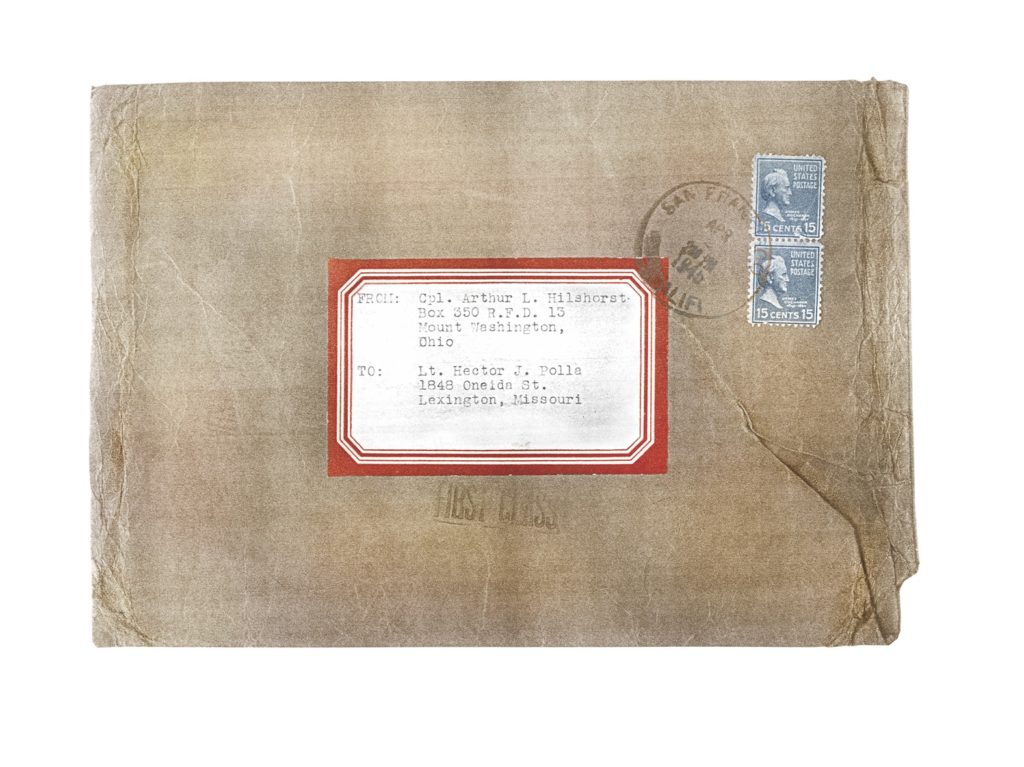
Hilshorst reached the U.S. Army’s Letterman Hospital in San Francisco in March 1945, and on April 2 he mailed the journals in a large single envelope to Polla’s home in Missouri. As the envelope arrived, Vico and Maddelina were still holding on to hope about the fate of their son. The parents later placed this envelope, along with General Witsell’s letters and Polla’s dry-cleaning, into the footlocker their son had brought home from West Point in June 1941. There they would remain for more than half a century. John Giorza told me that after his mother passed away in 1995, he and Jane opened the footlocker. They found Hilschorst’s envelope there, still sealed.

